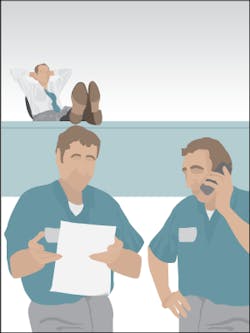Kelly Bennett cringed when he heard the story. A shop owner he knew was unpleased with the work of the facility’s service advisors at the front desk. This owner, Bennett says, knows how to manage his business: He’s the first one in the office, the last to leave; he keeps meticulous records; he is thorough, detail-oriented and cares deeply about his shop’s success. He cares so much, in fact, that to prove his point to the service advisors, he parked himself on a stool behind the counter and watched them work—for an entire eight-hour shift. He took notes and told the employees what they did right and wrong.
As one of the automotive industry’s foremost public speakers on leadership in North America, Bennett hears these types of stories all too much. His consulting company, Kelly the Coach Inc. (formerly Business Training International), works to train and coach shop owners on all aspects of running a business, focusing particularly on leadership and coaching.
—Kelly Bennett, business coach, Kelly the Coach, Inc.
This story of the shop owner and the stool—although fairly extreme—represents what Bennett says is the biggest problem in small business leadership.
“Most people in the automotive industry, or any small business for that matter, are not aware of the difference between being a manager and being a leader,” Bennett says. “In the case with the shop owner and the stools, if he wanted to be a leader, he should have grabbed two stools and had the employees sit in them. Then he should’ve worked the front desk to show them how it’s done.
“You see, the difference is that a manager will sit in the corner on the stool, trying to fix mistakes. A leader, a coach, will say, ‘Step back, I’ll show you. Follow my lead.’”
As Bennett puts it, people should manage tasks and lead people. It’s the difference between a “cop” and a “coach,” he says: A manager (i.e., the cop) looks to fix problems; the leader (i.e., the coach) is there to bring out the best in people.
Understanding how to effectively coach employees, Bennett says, is one of the most critical steps an owner can take toward business success.
Employees need their bosses to be coaches, Bennett says, leading them and getting the best out of them. Although it’s a fairly complex concept, Bennett has several simple tips for shop owners on becoming better coaches:
Inspire, don’t motivate.
Similar to managing and leading, inspiration and motivation are often confused, Bennett says. “The difference is that when you inspire someone, they do it on their own,” Bennett says. “The motivation comes through from being inspired.” The easiest way to understand it is by evaluating yourself, Bennett says. “As a business owner, working for that success is what motivates you. The other things that may come up, those inspire you to do things on your own,” he says. Another way to look at it: a coach’s pregame speech doesn’t motivate a team to win; it inspires the team to work for what it is already motivated to achieve. Bennett feels this is the most important aspect of leadership and coaching. It’s important to understand what motivates each employee—whether it’s career goals, family or even just a paycheck—and then using that to inspire them.
Share a vision.
Bennett says that every time he gives a speech, shop owners will rush up to him excitedly gushing about how they are going to hurry back to their shop and make all these changes. Then, they go to implement it and are met with resistance from their employees. “People are always resistant to change if they don’t understand the purpose of it,” Bennett says. “You can’t just go back and say we’re going to do this and this and this. You need to tell them that the reason we’re going to do this is because such and such—we’re getting poor documentation, etc. You have to make sure everyone is on the same page and shares that vision.”
Allow yourself to be challenged. Having regular staff meetings is important in coaching your employees, Bennett says. Leading those meetings correctly is even more important. “What makes a meeting work is conflict,” he says. “But most people aren’t going to challenge anything someone is saying because they want the meeting to be over. But then they’ll tell everyone in the days afterward what they thought of the meeting.” The key, Bennett says, is to make sure employees feel they can voice their opinions, that they can say to their boss what they would say to a co-worker in the bay 15 minutes later. “If you disagree, you disagree,” Bennett says, “but you need to get all your thoughts and ideas out there so everyone understands each other and can work effectively.” A shop owner needs to let employees know they can voice their opinions.
Learn from others.
As Bennett put it, “Developing your own leadership style starts by learning from as many leaders as you can.” While this can include signing up for seminars and conferences, Bennett says a simple thing to do is read as many leadership books as possible. A good goal, Bennett says, is to read one book every month. Movies, particularly some sports movies, can also help quite a bit. Great coaches and leaders have all learned from someone, whether it was a previous boss, a personal mentor or from a speaker or author. Bennett says you have to make sure you’re always open to learning. “It’s that old saying that you don’t know what you don’t know,” Bennett explains.




